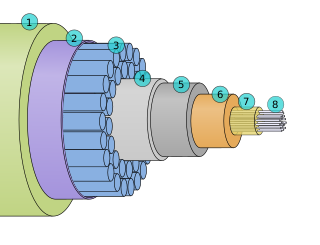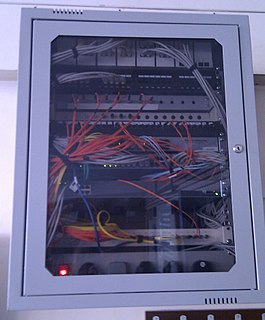Related Research Articles
TAT-6 was the sixth transatlantic telephone cable. It was in operation from 1976 to 1994, with a bandwidth of 12MHz between Green Hill and Saint-Hilaire-de-Riez, Vendée, (France).
TAT-8 was the 8th transatlantic communications cable and first transatlantic fiber-optic cable, carrying 280 Mbit/s between the United States, United Kingdom and France. It was constructed in 1988 by a consortium of companies led by AT&T Corporation, France Télécom, and British Telecom. AT&T Bell Laboratories developed the technologies used in the cable. The system was made possible by optical amplifiers acting as repeaters with advantages over the electrical repeaters of former cables. They were less costly and could be at greater spacing with less need for associated hardware and software. It was able to serve the three countries with a single transatlantic crossing with the use of an innovative branching unit located underwater on the continental shelf off the coast of Great Britain. The cable lands in Tuckerton, New Jersey, USA, Widemouth Bay, England, UK, and Penmarch, France.

A submarine communications cable is a cable laid on the sea bed between land-based stations to carry telecommunication signals across stretches of ocean and sea. The first submarine communications cables laid beginning in the 1850s carried telegraphy traffic, establishing the first instant telecommunications links between continents, such as the first transatlantic telegraph cable which became operational on 16 August 1858. Subsequent generations of cables carried telephone traffic, then data communications traffic. Modern cables use optical fibre technology to carry digital data, which includes telephone, Internet and private data traffic.

This article is about telecommunications systems in Armenia.
Telecommunications in Cuba consists mainly of NTSC analog television, analog radio, telephony, AMPS, D-AMPS, and GSM mobile telephony, and the Internet. Telephone service is provided through ETECSA, mobile telephone service is provided through the Cellular Telephone Company of Cuba (CUBACEL) and, previously, Caribbean Cellular. Cuba's main international telecommunications links are through Intersputnik, with limited effectiveness of undersea telephone cables to the Americas, Spain, and possibly Italy due to political interference into Cuba's internal political affairs by the United States.
LattisNet was a family of computer networking hardware and software products built and sold by SynOptics Communications during the 1980s. Examples were the 1000, 2500 and 3000 series of LattisHub network hubs. LattisNet was the first implementation of 10 Megabits per second local area networking over unshielded twisted pair wiring in a star topology.

Fiber to the x or fiber in the loop is a generic term for any broadband network architecture using optical fiber to provide all or part of the local loop used for last mile telecommunications. As fiber optic cables are able to carry much more data than copper cables, especially over long distances, copper telephone networks built in the 20th century are being replaced by fiber.

MedNautilus is a submarine telecommunications cable system linking countries bordering the Eastern/Central Mediterranean Sea. It is a successor of the LEV system linking Cyprus, Israel and Italy.

Fiber-optic communication is a method of transmitting information from one place to another by sending pulses of infrared light through an optical fiber. The light is a form of carrier wave that is modulated to carry information. Fiber is preferred over electrical cabling when high bandwidth, long distance, or immunity to electromagnetic interference is required. This type of communication can transmit voice, video, and telemetry through local area networks or across long distances.
The NEPTUNE Ocean Observatory project is part of Ocean Networks Canada which is a University of Victoria initiative. NEPTUNE is the world's first regional-scale underwater ocean observatory that plugs directly into the Internet. NEPTUNE is the largest installation on the Ocean Networks Canada network of ocean observatories. Since December 2009, it has allowed people to "surf" the seafloor while ocean scientists run deep-water experiments from labs and universities around the world. Along with its sister project, VENUS, NEPTUNE offers a unique approach to ocean science. Traditionally, ocean scientists have relied on infrequent ship cruises or space-based satellites to carry out their research, while the NEPTUNE project uses a remotely operated crawler.

A fiber-optic cable, also known as an optical-fiber cable, is an assembly similar to an electrical cable, but containing one or more optical fibers that are used to carry light. The optical fiber elements are typically individually coated with plastic layers and contained in a protective tube suitable for the environment where the cable is used. Different types of cable are used for different applications, for example, long distance telecommunication, or providing a high-speed data connection between different parts of a building.
Broadband Internet in Israel has been available since the late 1990s in theory, but it only became practically accessible to most customers in 2001. By 2008, Israel had become one of the few countries with developed broadband capabilities across two types of infrastructure—cable and DSL—reaching over 95% of the population. Actual broadband market penetration stands at 77%, ranked 7th in the world. in 2010, Israel was ranked 26th in The Economist's Digital Economy Rankings.
Unity is a Trans-Pacific submarine communications cable between Japan and the United States that was completed in April 2010.
TRANSPAC or Trans-pacific cable (TPC) is a series of undersea cables under the Pacific Ocean.

C.S. Sovereign is a class DP2 type cable ship used for subsea cable installation and repair works. The ship was designed by BT Marine with Hart Fenton & Company as Naval Architects and built by Van der Giessen de Noord in 1991.
The CS Chamarel, originally CS Vercors was a cable layer owned by France Telecom Marine, laying submarine communications cables around the world. It was built in 1974 and destroyed by a fire in August 2012. As the Vercors, the ship laid cables on and between all continents except Antarctica, including numerous trans-Atlantic cables and the first ever Israeli-made cable, and set the record for the deepest submarine buried cable lay in 2000. The ship was badly damaged by a fire in August 2012.

The Caucasus Cable System is a Georgian-owned submarine communications cable in the Black Sea linking Poti, Georgia to Balchik, Bulgaria over a distance of 1,182 km. Its landing station in Balchik is connected to Frankfurt, Germany and other European Internet hubs via terrestrial connection. As the only communications cable linking Georgia directly to Europe, the Caucasus Cable System is deemed of geostrategic importance and has been at the center of controversy due to alleged plans to sell it to a Russian-owned company. As of January 2017 the cable is still in sole ownership of Caucasus Online.

MAREA is a 6,600 km long transatlantic communications cable connecting the United States with Spain. Owned and funded by Microsoft and Facebook, but constructed and operated by Telxius, a subsidiary of the Spanish telecom company Telefónica, it is the "highest-capacity submarine cable in the world" with a system design capacity of 200 terabits per second.
The Quantum Cable is a planned 7,700 km submarine communications cable system connecting Asia with Europe through the Mediterranean Sea. It connects Cyprus, Greece, Israel, Italy, France and Spain. The Quantum Cable will be laid simultaneously with the 2,000 MW EuroAsia Interconnector.
References
- 1 2 Conneally, Tim (August 10, 2012). "Legendary Fiber Optic Cable Ship Burns to a Crisp on Skeleton Coast". Betanews. Retrieved August 11, 2012.